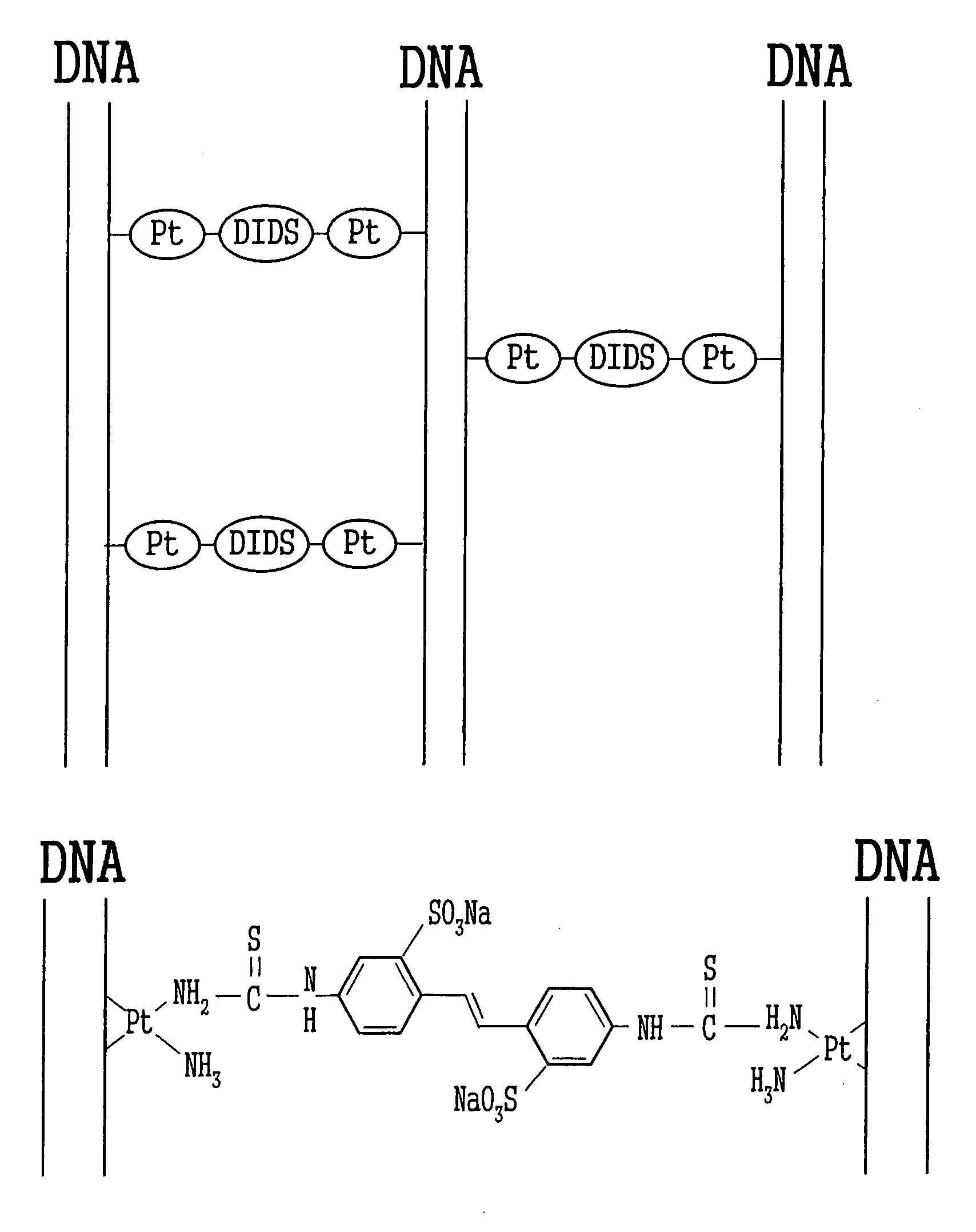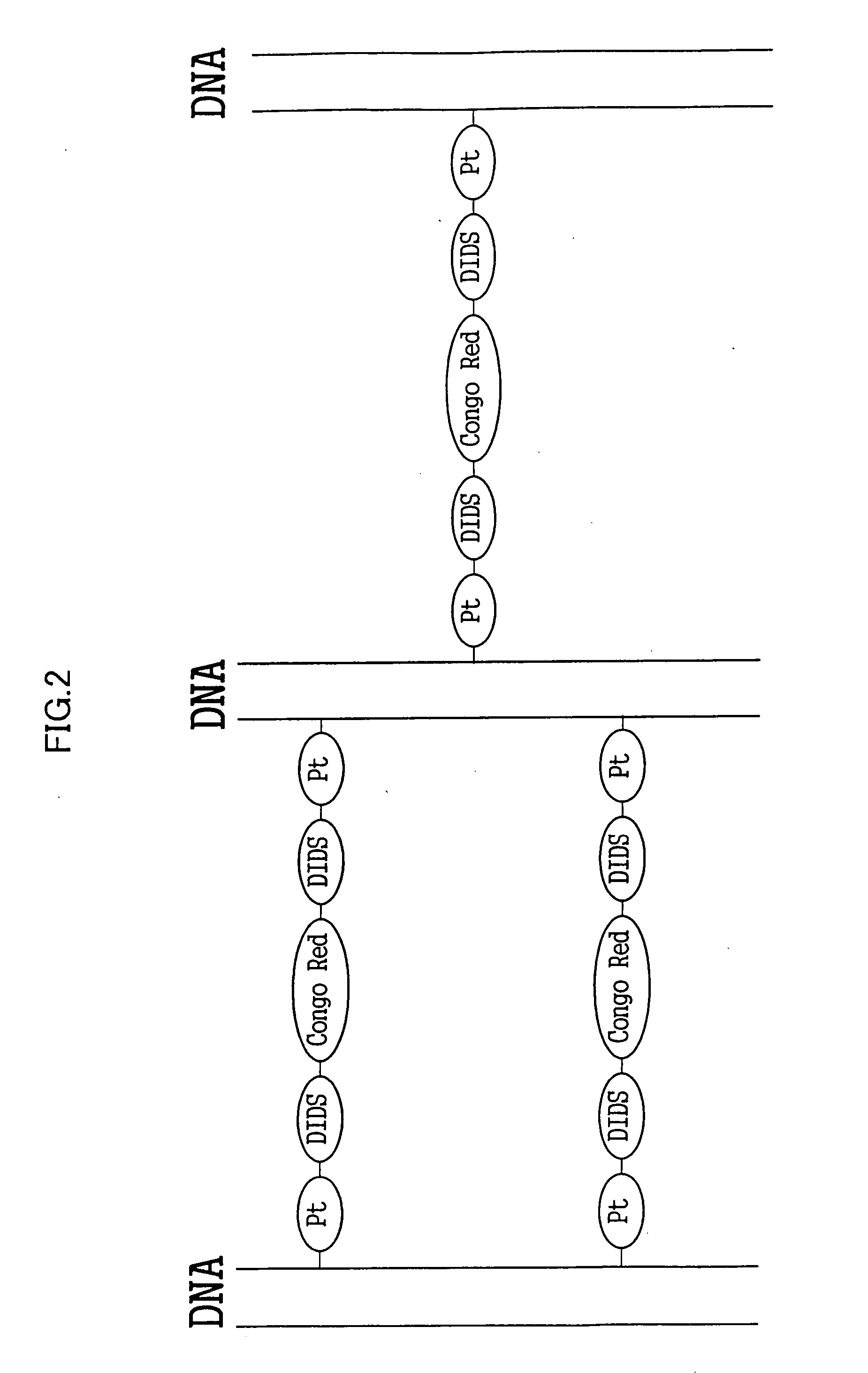Organic conductor
a conductor and organic technology, applied in the direction of conductors, non-metal conductors, nanoinformatics, etc., can solve the problems of inaccurate knowledge of the level at which a dna allows electricity to flow, no accurate conductivity measurement, and prior studies that have not been successful in determining
- Summary
- Abstract
- Description
- Claims
- Application Information
AI Technical Summary
Benefits of technology
Problems solved by technology
Method used
Image
Examples
example 1
[0053] The water employed was a super-pure water (having a resistance of 1018Ω or higher) obtained by purification using a super-pure water producing instrument MILLIQ manufactured by MILLOPORE. The DNA employed was a bacteriophage λcl857 Sam7-derived % DNA (TAKARA SHUZO Co., Ltd.). The KDNA was dissolved at 0.4 mg / ml in a TE buffer (Tris: 10 mM, EDTA: 1 mM, pH=8). First, 1 ml of the % DNA buffer solution was mixed with 80 μl of a 2.5 mg / ml aqueous solution of cis-platin (Sigma-Aldrich Co.). Then 301 μl of a 1 mg / ml aqueous solution of DIDS (DOJINDO LABORATORIES) and 400 μl of a 0.5 mg / ml aqueous solution of Congo Red (Wako Pure Chemical Industries, Ltd.) were added to the resultant mixture, and the mixture was kept at 55° C. for 3 days. The formation of the crosslinked construct represented by Formula 6 was identified on the basis of the results described below. A naturally occurring DNA has the maximum absorption wavelength of 260 nm in a UV and visible light absorption spectrum, ...
example 2
[0056] 400 μl of a 0.32 mg / ml KDNA buffer solution was mixed thoroughly with 12 μl of a 5 mg / ml aqueous solution of cis-platin and 300 μl of a 1 mg / ml aqueous solution of DIDS, and kept at 55° C. for 3 days. Similarly to Example 1, the crosslinked construct (A-2) shown in FIG. 11 was confirmed to be generated based on the UV and visible absorption spectrum and infrared absorption spectrum. To purify the crosslinked construct thus synthesized, ethanol precipitation was conducted. 200 μl of the reaction solution was taken out into a sample tube, and 20 μl of a 3 mol / l aqueous solution of sodium acetate and 400 μl of ethanol were added to and mixed thoroughly with the reaction solution. After being allowed to stand at room temperature for 1 hour, the mixture was centrifuged at 4° C. and 13,200 rpm for 30 minutes to separate the supernatant and the pellet. The pellet recovered was dissolved again in 10 μl of super-pure water. A drop of this aqueous solution was added by a microsyringe o...
example 3
[0057] Four single-stranded DNAs (hereinafter referred to as ssDNAs) of 120 bases represented by SEQ. ID. Nos. 1 to 4 were designated ssDNA1 to ssDNA4, respectively, each of which was synthesized by a phosphoramidite method using a DNA synthesizer Expedite 8909 manufactured by Applied Biosystems. There was complementarity of the base sequence between ssDNA1 and ssDNA2 and between ssDNA3 and ssDNA4, and a double-stranded DNA can be formed via hydrogen bonds by hybridization. The hybridization was effected by mixing respective ssDNAs at the molar ratio of 1:1 and the resultant mixture was kept at 97° C. for 5 minutes and then cooled to room temperature slowly. After forming a double-stranded DNA by the hybridization, ethanol precipitation was conducted for purification. A double-stranded DNA formed from ssDNA1 and ssDNA2 was designated G0, while a double-stranded DNA formed from ssDNA3 and ssDNA4 was designated G100. All regions other than the regions of 10 base pairs from the both te...
PUM
| Property | Measurement | Unit |
|---|---|---|
| thickness | aaaaa | aaaaa |
| hydrogen electrode potential | aaaaa | aaaaa |
| hydrogen electrode potential | aaaaa | aaaaa |
Abstract
Description
Claims
Application Information
 Login to View More
Login to View More - R&D
- Intellectual Property
- Life Sciences
- Materials
- Tech Scout
- Unparalleled Data Quality
- Higher Quality Content
- 60% Fewer Hallucinations
Browse by: Latest US Patents, China's latest patents, Technical Efficacy Thesaurus, Application Domain, Technology Topic, Popular Technical Reports.
© 2025 PatSnap. All rights reserved.Legal|Privacy policy|Modern Slavery Act Transparency Statement|Sitemap|About US| Contact US: help@patsnap.com



